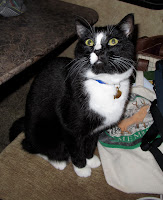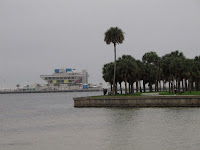We had planned to spend another day in Largo, but the weather didn’t look like it was improving, so we decided to leave and head north, which had a better forecast. Sure enough, as we approached Gainesville, the sky cleared and the mercury rose. Once we got away from Tampa’s urban sprawl, traffic lightened and we were treated to a pleasant landscape of rolling hills dotted with big, old oak trees and horse and cattle ranches.
We got to Paynes Prairie Preserve State Park around noon. Neptune took one look at all the trees and expansive woods around our campsite and demanded a walk. Vegetation under the oaks was sparse, so it was easy for him to walk and to see a long way off. He took off without a backward glance. This is why he’s not allowed off his leash when we’re camping. As usual, the cautious one was content to peek out from the safety of the trailer.
The park has a number of trails you can bike on, so we we set off biking, first on the Lake Trail, which was sandy and difficult to bike on, where we saw a gopher tortoise.
Then we went on the 8-mile roundtrip Cole’s Dike trail. It started out rooty and rough and then was mostly soft grass and quite exhausting to bike on. We saw some wild horses, two sandhill cranes
and a couple deer, but the bison were nowhere to be seen. I made it about 3 miles, then had to turn around. David biked another mile to the end and easily caught up with me.
Instead of the Lake Trail, we took another trail back to the campground, but it too had patches of sand and also some long, deep wet areas. Although I probably only biked around 10 miles, it felt like an endurance test.
In the morning we went to the visitor’s center, looked at the exhibits, watched an excellent video about the preserve and walked to the observation tower (still no bison). I saw two running deer and several flying sandhill cranes. David said the park had a good feel to it. He liked the big oak trees, the Spanish moss and the palmettos.
 In contrast, our next campground at O’Leno State Park, which was only an hour away, was mostly loblolly pine forest and looked quite different, although it too was nice. However, this day turned out to be cold and rainy. We probably would have kept on going if I hadn’t already made reservations. Since this was our last real vacation day, we bundled up and walked over to look at the Santa Fe River. We walked the 1.5-mile River Trail across the CCC suspension bridge, along the river, past big sink holes and past the Santa Fe River sink where the river descends beneath the earth and doesn’t emerge again for 3 miles downstream at the river rise. It rained the whole time, otherwise it would have been quite nice. We didn’t see alligators, although there were lots of signs warning of their presence. O’Leno used to be a town, and one of the buildings had an exhibit explaining the history. When we returned to the campsite, a pool of water had collected around our door. It rained hard the rest of the day.
In contrast, our next campground at O’Leno State Park, which was only an hour away, was mostly loblolly pine forest and looked quite different, although it too was nice. However, this day turned out to be cold and rainy. We probably would have kept on going if I hadn’t already made reservations. Since this was our last real vacation day, we bundled up and walked over to look at the Santa Fe River. We walked the 1.5-mile River Trail across the CCC suspension bridge, along the river, past big sink holes and past the Santa Fe River sink where the river descends beneath the earth and doesn’t emerge again for 3 miles downstream at the river rise. It rained the whole time, otherwise it would have been quite nice. We didn’t see alligators, although there were lots of signs warning of their presence. O’Leno used to be a town, and one of the buildings had an exhibit explaining the history. When we returned to the campsite, a pool of water had collected around our door. It rained hard the rest of the day.
We left the next day at 9:30 after dumping the tanks at the dump station. It turned into a warm, clear day, but windy. Nevertheless, we made good time and decided to continue past our original stopping place and push on. At 5:45 we arrived at our campground near the NC border. It was only two hours from home. If we weren’t towing the trailer, we would have continued on home, but we didn’t want to have to deal with the trailer in the dark.
The final day was a short, easy drive with almost constant meowing by Neptune. He seemed to know we were close to home and got more and more excited. Well, we’re all safe at home now, and it’s back to work for now.












































